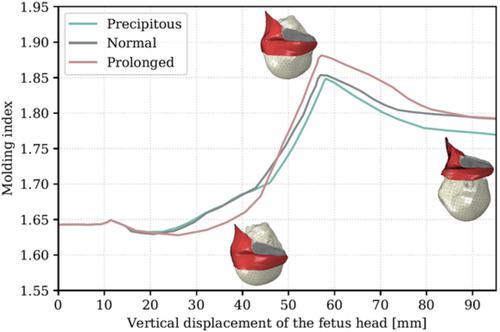当前位置:
X-MOL 学术
›
Int. J. Numer. Method. Biomed. Eng.
›
论文详情
Our official English website, www.x-mol.net, welcomes your
feedback! (Note: you will need to create a separate account there.)
A numerical study on fetal head molding during labor
International Journal for Numerical Methods in Biomedical Engineering ( IF 2.2 ) Pub Date : 2020-11-01 , DOI: 10.1002/cnm.3411 Rita Moura 1, 2 , Margarida Borges 1, 2 , Maria C P Vila Pouca 2 , Dulce A Oliveira 2 , Marco P L Parente 1, 2 , Nina Kimmich 3 , Teresa Mascarenhas 4 , Renato M Natal 1, 2
International Journal for Numerical Methods in Biomedical Engineering ( IF 2.2 ) Pub Date : 2020-11-01 , DOI: 10.1002/cnm.3411 Rita Moura 1, 2 , Margarida Borges 1, 2 , Maria C P Vila Pouca 2 , Dulce A Oliveira 2 , Marco P L Parente 1, 2 , Nina Kimmich 3 , Teresa Mascarenhas 4 , Renato M Natal 1, 2
Affiliation

|
During vaginal delivery, the fetal head molds into an elongated shape to adapt to the birth canal, a process known as fetal head molding. However, excessive molding can occur due to prolonged labor or strong contractions, leading to several disorders on the fetal head. This work aims to perform a numerical study on the biomechanics of fetal head molding by measuring specific diameters and the corresponding molding index. A finite element model of the pelvic floor muscles and the fetal body was used. The fetal head is composed of the skin and soft tissues, the skull with sutures and fontanelles, and the brain. The sutures and fontanelles were modeled with membrane elements and characterized by a visco‐hyperelastic constitutive model adapted to a plane stress state. Simulations were performed to replicate the second stage of labor in the vertex presentation and occipito‐anterior position. With the introduction of viscoelasticity to assess a time‐dependent response, a prolonged second stage of labor resulted in higher molding. The pressure exerted by the birth canal and surrounding structures, along with the presence of the pelvic floor muscles, led to a percentage of molding of 9.1%. Regarding the pelvic floor muscles, a 19.4% reduction on the reaction forces and a decrease of 2.58% in muscle stretching was reported, which indicates that sufficient molding may lead to fewer injuries. The present study demonstrates the importance of focusing on the fetus injuries with non‐invasive methods that can allow to anticipate complications during labor.
中文翻译:

分娩时胎头成型的数值研究
在阴道分娩过程中,胎头成型为细长的形状以适应产道,这一过程称为胎头成型。然而,由于长时间的分娩或强烈的宫缩会导致过度成型,从而导致胎头出现多种疾病。本工作旨在通过测量特定直径和相应的成型指数,对胎头成型的生物力学进行数值研究。使用了盆底肌肉和胎儿身体的有限元模型。胎头由皮肤和软组织、带有缝线和囟门的颅骨以及大脑组成。缝合线和囟门用膜元件建模,并以适应平面应力状态的粘超弹性本构模型为特征。进行模拟以在顶点呈现和枕前位置复制第二产程。通过引入粘弹性来评估时间依赖性反应,延长的第二产程会导致更高的成型率。产道和周围结构施加的压力,以及盆底肌肉的存在,导致了 9.1% 的成型百分比。关于盆底肌肉,据报道反作用力减少了 19.4%,肌肉拉伸减少了 2.58%,这表明充分的塑形可能会导致更少的伤害。本研究证明了使用非侵入性方法关注胎儿损伤的重要性,这些方法可以预测分娩期间的并发症。通过引入粘弹性来评估时间依赖性反应,延长的第二产程会导致更高的成型率。产道和周围结构施加的压力,以及盆底肌肉的存在,导致了 9.1% 的成型百分比。关于盆底肌肉,据报道反作用力减少了 19.4%,肌肉拉伸减少了 2.58%,这表明充分的塑形可能会导致更少的伤害。本研究证明了使用非侵入性方法关注胎儿损伤的重要性,这些方法可以预测分娩期间的并发症。通过引入粘弹性来评估时间依赖性反应,延长的第二产程会导致更高的成型率。产道和周围结构施加的压力,以及盆底肌肉的存在,导致了 9.1% 的成型百分比。关于盆底肌肉,据报道反作用力减少了 19.4%,肌肉拉伸减少了 2.58%,这表明充分的塑形可能会导致更少的伤害。本研究证明了使用非侵入性方法关注胎儿损伤的重要性,这些方法可以预测分娩期间的并发症。随着骨盆底肌肉的存在,导致了 9.1% 的成型百分比。关于盆底肌肉,据报道反作用力减少了 19.4%,肌肉拉伸减少了 2.58%,这表明充分的塑形可能会导致更少的伤害。本研究证明了使用非侵入性方法关注胎儿损伤的重要性,这些方法可以预测分娩期间的并发症。随着骨盆底肌肉的存在,导致了 9.1% 的成型百分比。关于盆底肌肉,据报道反作用力减少了 19.4%,肌肉拉伸减少了 2.58%,这表明充分的塑形可能会导致更少的伤害。本研究证明了使用非侵入性方法关注胎儿损伤的重要性,这些方法可以预测分娩期间的并发症。
更新日期:2020-11-01
中文翻译:

分娩时胎头成型的数值研究
在阴道分娩过程中,胎头成型为细长的形状以适应产道,这一过程称为胎头成型。然而,由于长时间的分娩或强烈的宫缩会导致过度成型,从而导致胎头出现多种疾病。本工作旨在通过测量特定直径和相应的成型指数,对胎头成型的生物力学进行数值研究。使用了盆底肌肉和胎儿身体的有限元模型。胎头由皮肤和软组织、带有缝线和囟门的颅骨以及大脑组成。缝合线和囟门用膜元件建模,并以适应平面应力状态的粘超弹性本构模型为特征。进行模拟以在顶点呈现和枕前位置复制第二产程。通过引入粘弹性来评估时间依赖性反应,延长的第二产程会导致更高的成型率。产道和周围结构施加的压力,以及盆底肌肉的存在,导致了 9.1% 的成型百分比。关于盆底肌肉,据报道反作用力减少了 19.4%,肌肉拉伸减少了 2.58%,这表明充分的塑形可能会导致更少的伤害。本研究证明了使用非侵入性方法关注胎儿损伤的重要性,这些方法可以预测分娩期间的并发症。通过引入粘弹性来评估时间依赖性反应,延长的第二产程会导致更高的成型率。产道和周围结构施加的压力,以及盆底肌肉的存在,导致了 9.1% 的成型百分比。关于盆底肌肉,据报道反作用力减少了 19.4%,肌肉拉伸减少了 2.58%,这表明充分的塑形可能会导致更少的伤害。本研究证明了使用非侵入性方法关注胎儿损伤的重要性,这些方法可以预测分娩期间的并发症。通过引入粘弹性来评估时间依赖性反应,延长的第二产程会导致更高的成型率。产道和周围结构施加的压力,以及盆底肌肉的存在,导致了 9.1% 的成型百分比。关于盆底肌肉,据报道反作用力减少了 19.4%,肌肉拉伸减少了 2.58%,这表明充分的塑形可能会导致更少的伤害。本研究证明了使用非侵入性方法关注胎儿损伤的重要性,这些方法可以预测分娩期间的并发症。随着骨盆底肌肉的存在,导致了 9.1% 的成型百分比。关于盆底肌肉,据报道反作用力减少了 19.4%,肌肉拉伸减少了 2.58%,这表明充分的塑形可能会导致更少的伤害。本研究证明了使用非侵入性方法关注胎儿损伤的重要性,这些方法可以预测分娩期间的并发症。随着骨盆底肌肉的存在,导致了 9.1% 的成型百分比。关于盆底肌肉,据报道反作用力减少了 19.4%,肌肉拉伸减少了 2.58%,这表明充分的塑形可能会导致更少的伤害。本研究证明了使用非侵入性方法关注胎儿损伤的重要性,这些方法可以预测分娩期间的并发症。











































 京公网安备 11010802027423号
京公网安备 11010802027423号